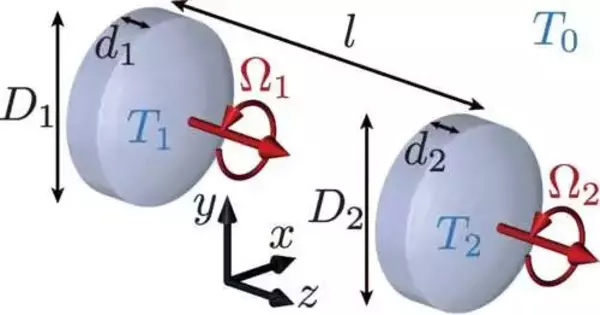Electromagnetic radiation is the main way that hot bodies release heat. Examples of technologies based on this physical phenomenon include lightbulbs and night vision equipment. According to what we observe on a daily basis, heat is always transferred from hot bodies to cold ones.
Researchers have just found that this is not always the case for rotating nanostructures in a new study led by Alejandro Manjavacas, a professor of physics and astronomy at the University of New Mexico. The production of thermophotovoltaic energy and the thermal management of electronic devices may both benefit from this discovery.
Control of the Radiative Heat Transfer in a Pair of Rotating Nanostructures, the title of the study’s findings, was released in Physical Review Letters.
“The important discovery is that rotation can change the radiative heat transfer between two nanostructures. In the absence of rotation, such radiative heat transfer is dictated entirely by the temperatures of the nanostructures. Nevertheless, as we demonstrate in our work, this transfer can be amplified, reduced, or even reversed when they rotate.”
Astronomy Professor Alejandro Manjavacas,
The researchers, who also included Juan R. Deop-Ruano from the Institute of Optics in Madrid, Spain, showed that the radiative heat transfer between two rotating nanostructures can be increased, decreased, or even reversed in comparison to the transfer that takes place in the absence of rotation, depending on their rotation frequencies.
Using the rotation of the nanostructures, this enables researchers to have more control over the radiative heat transfer.
The primary discovery, according to Manjavacas, is that rotation can alter the radiative heat transfer between two nanostructures. “In the absence of rotation, such radiative heat transfer is solely governed by the temperatures of the nanostructures. However, as we demonstrate in our work, this transfer can be increased, muted, or even reversed when they rotate.
The electromagnetic field’s thermal oscillations are what cause radiant heat transfer to occur between material structures. Due to the contribution of the near-field components of the electromagnetic field, radiative heat transfer can significantly outperform Planck’s Law when the distance between the structures is much smaller than the wavelength of the thermal radiation. The electromagnetic resonances of the structures’ strong responses further improve radiative heat transfer if the structure’s dimensions are also within that range.
Regarding applications, Manjavacas stated that “any fundamental advancement in our comprehension of radiative heat transfer can help to improve the technologies that are based on it.” The creation of thermophotovoltaic energy and the control of electronic device temperature at the nanoscale are the main examples.
Transistors used in microchips are now nanoscale in size due to recent advancements in electronics. These systems’ extremely difficult cooling is a major issue. A thorough understanding of radiative heat transfer enables the development of new heat-extraction mechanisms and, as a result, more effective cooling technologies.
According to Manjavacas, finding new ways to regulate radiative heat transfer is essential for overcoming technological obstacles in heat management and energy production. For instance, the production of thermophotovoltaic energy relies on the conversion of heat into electromagnetic radiation, which is then absorbed by a photovoltaic cell to generate electricity. This process is more effective because the radiative heat transfer is under control.
The conversion of heat into motion is one of the potential future directions that researchers are considering.
Using Casimir interactions, Manjavacas said, “We are interested in exploring the possibility of converting heat into motion.”. “Another intriguing option is to investigate the interaction between rotation and magneto-optical responses in the context of radiative heat transfer and Casimir torque.”.
More information: Juan R. Deop-Ruano et al, Control of the Radiative Heat Transfer in a Pair of Rotating Nanostructures, Physical Review Letters (2023). DOI: 10.1103/PhysRevLett.130.133605





